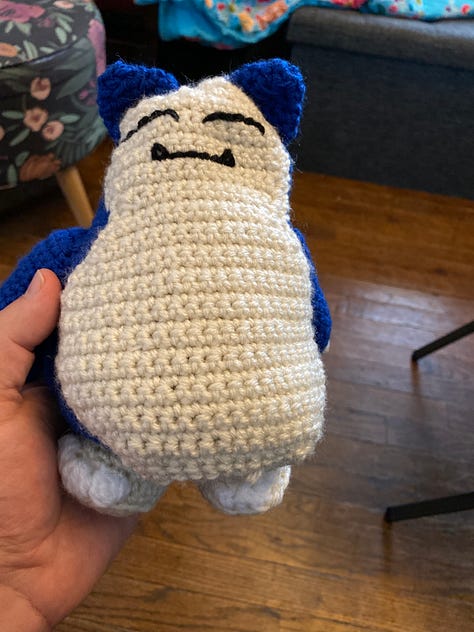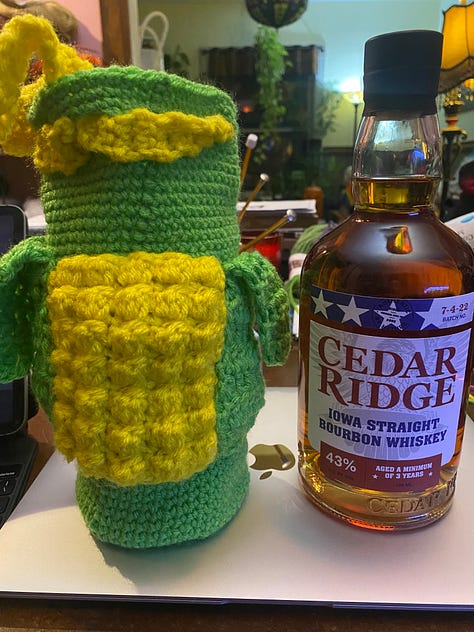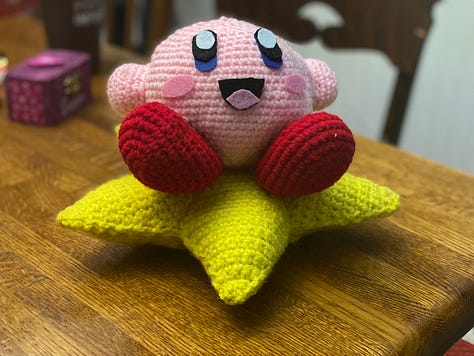There's no way to get out of it
On craft and creation and doing the work
Do you like my new sweater? I finished it yesterday morning. For the yarn nerds out there, I made it by doubling Caron Cloud Cakes Kelp and Lava with a 7.0 mm hook and followed this pattern from Home of the Hook. I’ve made this sweater a few times before, which saved me a little time, but it still took me about 20 hours to complete it.
Depending on how you look at it, 20 hours is either pretty fast or really inefficient. This is the first time I’ve ever tracked how long it took me to make a sweater, or anything really, and I wonder now why I waited so long to do it, since the second most common question I get about my stuff, after “did you make it yourself?” is “how long did that take?”
I can actually answer that question in 3 ways: stopwatch time (which I did above), calendar time, and number of days. I started working on this the day after Christmas, so by the calendar it took me 2 1/2 weeks. But I didn’t work on it every day, and most days I only worked on it for maybe an hour, two max, so it took 13 individual days.
I started crocheting about 5 1/2 years ago, I guess, while rehabbing from surgery on my left elbow which I shattered after falling on ice outside my office. I did physical therapy but wanted something that I’d be able to continue once that ended, so I tried this and it took. I got a kit and a book and talked to my mother-in-law, who has crocheted for years, and when I hit a couple of walls, remembered/discovered that the best thing about YouTube, its only saving grace really, is that it’s full of videos on how to do/fix shit. And then it was on.
At first, I was not good. My stitches were uneven, some loose, some tight. I’d miss stitches, accidentally double things up. My early scarves got wider and thinner, and the edges were ragged. My stuffed animals were limp and you could see the filling between the stitches. I missed stitches and wouldn’t realize it for 3 or 4 rows. Some days it felt like I tore out as much work as I’d done or more.






But I kept at it and got better. I watched other people and tried what they tried but also kept what I did well. I experimented and some of those experiments came out great and some of them didn’t but I always learned something from the attempt.
Does it sound like I’m talking about writing too? Because I am.
A couple of months ago I was rearranging some stuff in my office and came across some notebooks from when I was in my MFA in the early 2000’s and from my undergrad days. I looked back at some of those poems and felt the expected cringe but I also saw the origins of what would become my book and the poems that followed.
One of the most valuable things I learned early on as a student in creative writing was to look at writing as a craft. It happened in my first poetry workshop, as an undergrad, with Jack Bedell. He talked about how poetry comes from the Greek word poesis, which roughly translates to “the made thing.” We read from an anthology with that title, published by the University of Arkansas Press, but more importantly we talked about the importance of writing as practice, as something you can improve at, and moved away from the idea of poet as genius with some innate ability to organically blob words out onto the page.
Which is not to say geniuses don’t exist. It’s just to say that geniuses don’t start out there. Octavia Butler didn’t write didn’t write Parable of the Sower right out of the box. It took her years of honing her craft to get there.
It’s more important than ever to talk about this kind of work because the argument from many of AI and LLM companies, especially their CEO’s, is that these tools can let anyone become an artist, and it’s just not true.
Let me clarify. Anyone can create art and by extension become an artist. I’ll even go so far as to say that anyone can become a good artist, with the usual caveat that “good” is in the eye of the beholder.
What isn’t true is that those tools can get you out of the work it takes to get there.
One reason that tech CEOs are pushing the idea that these tools can turn anyone into an artist is they’re hoping to sell these tools to people who might believe this is the only way they can become artists, people who’ve been told that taking classes on how to paint or write or make music aren’t a good use of resources, who’ve been told that they’re left-brained and so aren’t wired to be creative, who believe that these tools will help them make money and get famous (which, ha! Anyone who thinks the path to riches comes through making art knows nothing about that world.)
Part of their argument is that it’s not fun to make art. That’s what Mikey Shulman, CEO of Suno AI said recently.
"It’s not really enjoyable to make music now," he said. "It takes a lot of time, it takes a lot of practice, you need to get really good at an instrument or really good at a piece of production software."
I wonder how long Shulman thought it took to make music in the days before his AI tools existed? How long it took for musicians to get good at playing their instruments, for producers and engineers and arrangers to learn how to master their equipment?

I don’t actually wonder that. It’s clear from his statement that he doesn’t know or care about the work that goes into making a song. I do expect he would be all up in his feelings if people suggested that an AI agent could do the job of Suno AI CEO better than he could because he at least has a sense of the work that went into getting there and values it as a result. “It’s way more complicated than it seems from the outside” he might say, and honestly, I’d believe him. That’s outside my knowledge and experience base.
What I do know, from every experience I’ve had as a writer, as a crocheter, as someone who plays guitar poorly and not often enough, as a teacher, is that you get better through practice and learning from experiments. No tool can shortcut that for you. I also know that there’s joy in the process, in success and failure alike.
The thing the makers of these tools are trying to sell is the idea that you can be creative without working at it, that you can ascend to genius level without any sweat. It’s the “one simple trick” sales pitch to be an artist, but there’s never “one simple trick” to succeeding at something. There’s just work, whether you’re crocheting a sweater or writing a song or running the expo window on a Friday night when a third of your wait staff called in sick and there are two new people on the line. Yes, doing that last bit well is an art too.
But also, we need to get past the idea that mega-financially-successful is the determiner of success in art. Back when we lived in San Francisco and worked at Anchor Brewing, Amy and I had a co-worker whose absolute beater of a car had a “Real Musicians Have Day Jobs” bumpersticker on it. Now I’m not here suggesting that artists who have hit it big aren’t creating amazing art. I’m not one of those “popular = bad/sellout” people. Sometimes art appeals to a big audience. Sometimes it’s niche. But the people who are selling this software are doing it by suggesting that if you use their tools, you too can be living like a king in Patagonia after just a little effort.
If that sounds like a get rich quick scheme, that’s because it is. I don’t know if the people running these companies are good at running the schemes. We’ll see how much money they walk away with when it all collapses and be able to judge then. But if they succeed, you can bet that it won’t have been because they used one simple trick. It’ll be because they worked at it long enough to get good at separating other people from their money.
One thing that every crocheter/knitter I’ve ever talked to jokes about is the amount of yarn they buy. There is never enough. You’re either buying for the project you want to do or for the project you haven’t thought of yet. But even if you have a big family who humors your obsession, eventually you’ve made all the scarves/hats/sweaters/fingerless gloves/mittens/lap blankets/full-sized blankets/stuffed animals/doilies/potholders etc that you’ll ever need or want. But you still have the urge to knot yarn into fabric. So what can you do?
My mother-in-law has made blankets for the NICU at a nearby hospital. You have to be in contact with the people who run it because there are strict requirements on the kinds of yarn you can use and what size the blankets can be, but that’s an option. She’s also made blankets for rescues in animal shelters. Same deal about requirements, but they tend to be a little looser.
Me, I like to make hats. It’s a form that allows me to experiment if I want but fall back to a familiar pattern if I don’t. I especially find myself doing them if I want to avoid being sucked into my phone because I can’t doomscroll if I don’t have a free hand. But again, I only need so many of them.
Fortunately, we have a Little Free Library and a lot of foot traffic past our place, so in the not-winter, I make hats and scarves and in the winter, I put them in the LFL with a little note so the people who see them don’t think they belong to someone else.
I’d love to read your thoughts on art and craft and practice and creation, no matter what you work in. How do you share it? How long have you worked at it? How has your approach changed over time? I love that kind of thing.
Thanks as always for reading. Next post will be about poems, I promise.




I've always said anyone can draw and I mean it. You may not like what you draw or think it's bad, but the way you get better at it is to do it over and over and over. When I was a teenager, I talked my dad into letting me take figure drawing classes at the Art Student League in NYC, Every weekend for I don't know how long, I rode in and sat and drew, from very short poses, barely to get a gesture, to long poses. I was not very good at first, but any current facility I have with drawing or painting or printmaking is rooted in those hours and hours of work.
It's true for making anything for any craft, for any art, you have to do it over and over to learn it and to learn yourself in it.
I love that sweater. It's so pretty and looks so comfy.
I wrote some of my thoughts regarding art and craft on the About page for my Substack, which is also how I distribute some of my writing. I send most of it to my writer's group. I submit to literary journals.
I studied visual art in college, and I'm always telling myself that I'll get back to it soon. I used to crochet when I was in high school (my mom taught me), but I haven't touched yarn in decades. Sometimes, I think, "I'd like to try that, again, sometime."
Most of my thoughts on art and craft mirror yours. I've never been one of those, "I hate writing, but I love having written." For me, it's always been the other way around. I write because I can't help myself. I did it secretly throughout most of my life. I hid my notebooks. I blogged anonymously. I was almost ashamed of my output because I wrote multiple times per day.
My art is my play. I would no more outsource it than I would outsource my tv watching or novel reading. Actually, I'm much more likely to outsource my tv watching. My art is how I access my truth. Somehow, I don't think AI could do that for me.